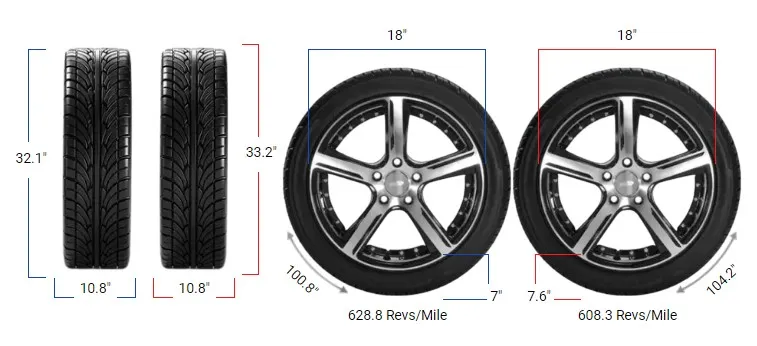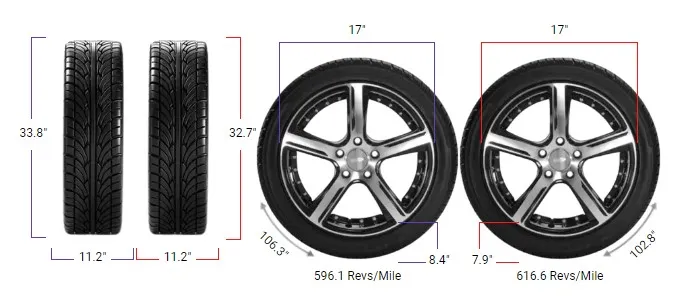Tire Size 275/65r20 vs 35×12.50r20

Tire upgrades can significantly impact your vehicle’s performance and appearance. Let’s explore the switch from 275/65r20 to 35×12.50r20 tires, examining the differences and their effects on your driving experience.
- Diameter increases by 0.95 inches for slightly better ground clearance
- Width expands by 1.69 inches improving traction and stability
- Sidewall height rises by 0.47 inches potentially enhancing ride comfort
- Revolutions per mile decrease by 16.03 impacting fuel economy slightly
- Wider profile may require minor vehicle modifications to prevent rubbing
- Larger size offers improved off-road capability with minimal on-road impact

Fitment Guide
It’s crucial to stay within the recommended 3% diameter difference. The switch from 275/65r20 to 35×12.50r20 results in a 2.8% increase in diameter, falling within the acceptable range.
This means the interchange is generally recommended, but some minor adjustments may be necessary to ensure proper fitment.
On-Road Impact
Changing tire sizes can affect various aspects of your on-road driving experience. Let’s examine how the switch to 35×12.50r20 tires influences your vehicle’s performance on paved surfaces.
- Gas Mileage: The wider and slightly larger 35×12.50r20 tires may lead to a minor decrease in fuel efficiency. The increased rolling resistance and weight can cause your engine to work a bit harder, potentially reducing your miles per gallon by a small margin.
- Ride Comfort: The taller sidewall of the 35×12.50r20 (7.51 inches vs. 7.04 inches) might provide a slightly cushier ride, absorbing road imperfections more effectively. However, the difference is minimal and may not be noticeable to most drivers.
- Speedometer Accuracy: The 2.8% increase in tire diameter will affect your speedometer readings. At 20 mph, your actual speed will be 20.56 mph. While this difference is small, it’s worth keeping in mind, especially at higher speeds or during long trips.
- Handling: The wider tires may offer improved grip on dry pavement, potentially enhancing cornering ability. However, they might also increase the risk of hydroplaning in wet conditions due to the larger contact patch.

Off-Road Impact
For those who enjoy venturing off the beaten path, the switch to 35×12.50r20 tires can bring some notable benefits. Here’s how the change affects your off-road capabilities.
- Ground Clearance: The 0.95-inch increase in diameter translates to approximately half an inch of additional ground clearance. This may seem small, but it can make a difference when navigating over rocks, logs, or other obstacles.
- Traction: The wider tread of the 35×12.50r20 tires provides a larger contact patch with the ground, potentially improving grip on loose surfaces like sand, mud, or gravel.
- Flotation: The increased width can help distribute the vehicle’s weight over a larger area, reducing the likelihood of sinking in soft terrain such as snow or sand.
- Durability: Larger tires with taller sidewalls are generally more resistant to punctures and damage from off-road hazards, potentially increasing their longevity in rugged conditions.
Aesthetics
The switch to 35×12.50r20 tires will give your vehicle a more imposing look. The wider, taller profile creates a more aggressive stance, which many off-road enthusiasts prefer.
However, this change may also make your vehicle appear less streamlined for those who prefer a sleeker appearance.
What is the Difference Between 275/65r20 and 35×12.50r20?
The primary distinction between these tire sizes lies in their width. The 35×12.50r20 is notably wider at 12.52 inches compared to the 275/65r20’s 10.83 inches, resulting in a 15.6% increase. This extra width can provide improved traction and a more aggressive look.
Can I Use 35×12.50r20 Instead of 275/65r20?
Yes, you can use 35×12.50r20 instead of 275/65r20. The diameter difference is 2.8%, which falls within the recommended 3% limit for tire size changes. However, due to the increased width, some minor vehicle modifications may be necessary to prevent rubbing.
How Much Taller Is a 35×12.50r20 Tire Than a 275/65r20?
A 35×12.50r20 tire is 0.95 inches (24.1 mm) taller than a 275/65r20 tire. The 35×12.50r20 has a diameter of 35.02 inches, while the 275/65r20 has a diameter of 34.07 inches, resulting in a 2.8% increase in height.
How Much Wider is a 35×12.50r20 Tire Than a 275/65r20?
A 35×12.50r20 tire is 1.69 inches (43 mm) wider than a 275/65r20 tire. The 35×12.50r20 has a width of 12.52 inches, while the 275/65r20 has a width of 10.83 inches, representing a 15.6% increase in width.
275/65r20 vs 35×12.50r20 Table
This table offers a clear comparison of the two tire sizes, helping you understand their variations in key dimensions and performance metrics.
| Feature | 275/65R20 | 35×12.50R20 | Difference |
|---|---|---|---|
| Diameter inches (mm) | 34.07 (865.5) | 35.02 (889.6) | 0.95 (24.1) +2.8% |
| Width inches (mm) | 10.83 (275) | 12.52 (318) | 1.69 (43) +15.6% |
| Circumference inches (mm) | 107.05 (2719.05) | 110.03 (2794.76) | 2.98 (75.71) +2.8% |
| Sidewall Height inches (mm) | 7.04 (178.75) | 7.51 (190.8) | 0.47 (12.05) +6.7% |
| Revolutions per mile (km) | 591.88 (367.78) | 575.84 (357.81) | -16.03 (-9.96) -2.7% |
| Speedo Reading | 20 mph | 20.56 mph | +0.56 mph |
Our Observation
Switching from 275/65r20 to 35×12.50r20 tires offers a balanced compromise between on-road and off-road performance. The modest increase in diameter enhances ground clearance and off-road capabilities without significantly impacting on-road behavior.
The wider profile improves traction in various conditions but may slightly reduce fuel efficiency. While the change in speedometer accuracy is minimal, it’s worth noting for long trips or high-speed driving.
Overall, this tire upgrade provides noticeable benefits for off-road enthusiasts without major drawbacks for daily driving, making it a solid choice for those seeking a more versatile tire setup.



